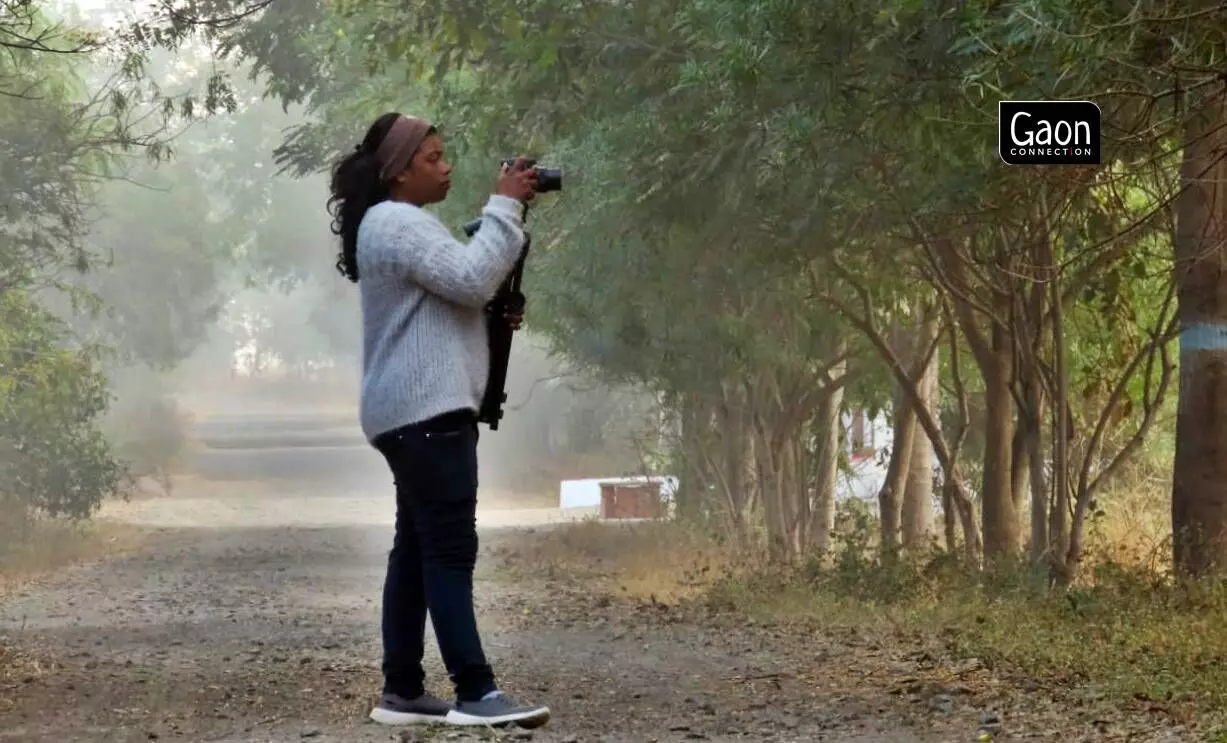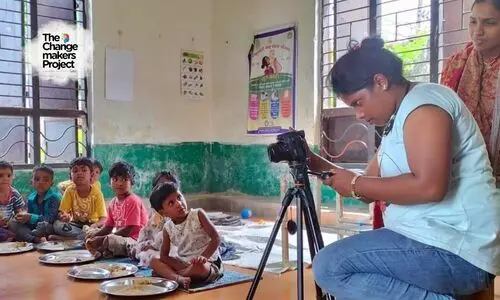Jamshedpur, Jharkhand
A mop of hair comes into focus and the camera pans down to the grubby face of a little girl, no more than seven or eight years old, scrubbing a pile of vessels. In the background is a tall chimney, an ominous indication that brick kilns are not too far away.
This is the opening shot of the short film Ummeed Uddano Ki – Pankh Phaila, Aasmaan Chhoone Ki, about children who accompany their parents who migrate in search of livelihoods.
The 18 minute-film found mention at the annual conclave for tribal communities called Samvaad, organised by the Tata Steel Foundation (TSF) last month in Jamshedpur. And its maker, 29-year-old Mary Sandhya Laakra, who is from the Oraon Adivasi community, was invited to participate in a five day workshop organised by Samuday ke Saath, a platform to explore tribal narratives through cinema.
WATCH THE SHORT FILM HERE
In November this year, Samuday ke Saath gathered together filmmakers who documented lives of tribal communities, their problems, their traditions and cultures, their music, food and folklore.
The initiative began in 2015 by TSF to understand, harness and disseminate the power of cinema as a medium to highlight tribal cultural identity and foster an alternative perspective on development surrounding tribal communities in India.
And Laakra’s documentary, Ummeed Uddano Ki – Pankh Phaila, Aasmaan Chhoone Ki, did just that. It highlighted a very real and present issue faced by tribal communities across the country, with a focus on Jharkhand. Laakra was delighted her debut documentary made the cut.
“I learnt about Samvaad from the internet. I entered my documentary and it was selected by a jury. I was then invited by Samuday Ke Saath, to take part in a five-day workshop on film making in Jamshedpur,” the young filmmaker told Gaon Connection.
Describing it as a unique opportunity, Laakra said that Samuday ke Saath provided filmmakers like her a chance to hone their skills and interact with filmmakers from other parts of the country who did similar work, and it helped raise awareness amongst people about what it was like to be a part of a tribal community.
To share her documentary on tribal migrant labourers at TSF’s conclave that was all about tribal communities was an honour, she said. The jury of filmmakers selected Laakra’s documentary as it was about a subject that was very real and present to so many tribal communities.
There are hundreds and thousands of children of tribal migrant labourers who lack a stable education or are not educated at all. Their plight moved Laakra to make a film about them.
Laakra comes from Sanghri village in Chatra district of Jharkhand. “There is a huge exodus of labourers who migrate from Chatra where I come from, but the film I have made is in Khunti district,” Laakra explained.
In the film, she records social activists worrying about how migration and trafficking of children are closely linked.
Laakra believed that platforms like Samvaad and Samuday would shine the spotlight on the trials and tribulations of tribal communities.

So far, since 2015, more than 70 filmmakers from tribal communities have trained here. Laakra was one of the three community filmmakers who was selected this year.
“The lack of livelihood opportunities in our villages is a huge challenge. I have witnessed injustice, crime and atrocities first hand in my village and I wish to bring about a positive social change through my films,” Laakra, told Gaon Connection.
“At Samuday Ke Saath, I learnt so much from the experts who spoke to us about script writing, pitching out films, how to raise funds and so on. But the best takeaway for me was that it presented me with an opportunity to meet and interact with the tribal filmmakers from other states such as Assam, Odisha and Nagaland. It helped me understand how other communities are documenting their struggles. Participating in the workshop has given me so many new ideas that I will work on,” Laakra said.
Some of the renowned filmmakers who have received training under this programme include Sneha Mundari who is now teaching at National Institute of Design and Deepak Baisra, who has started his own film festival in Odisha. It’s called the Baripada Short Film Festival.
Kumar Gaurav, who leads the Samuday ke Saath programme in Jamshedpur, explained the initiative.
“There are two parts to the initiative. There is an institutional branch of our programme that trains filmmakers who have graduated from formal institutions such as the Film and Television Institute of India (FTII), while a community branch trains people from indigenous communities who have a flair for filmmaking,” he said. Laakra belongs to the latter group.
Each year, films of three community filmmakers and two institutional filmmakers are selected by a jury and their makers are invited for the Samuday ke Saath Programme.

For Laakra, Samuday ke Saath has left her brimming with ideas and she is also documenting traditional Adivasi food.
So far, since 2015, more than 70 filmmakers from tribal communities have trained here. Laakra was one of the three community filmmakers who was selected this year.
Speaking of the documentaries made by indigenous communities, Kumar Gaurav said, “Often the films shot by tribal filmmakers like Laakra, despite the absence of expensive equipment, are better than the films shot by professional filmmakers. It is because the filmmakers from the community understand the socio-cultural nuances better. Their understanding reflects in their films.”
Nitish Kumar, Laakra’s mentor in Samuday ke Saath, was all praises for her flair for filmmaking. “Her ability to visually document her stories with meagre resources is exceptional. She edits the movies on her phone despite the fact that it can lead to several technical glitches. But she is patient and persevering,” Nitish Kumar told Gaon Connection.
He is a filmmaker and has been part of projects that have made films and documentaries in Ranchi, Kolkata and Mumbai. He has been working as a trainer at Tata Steel Foundation, since 2020.
Laakra visited at least five villages in Ranchi and Khunti districts, and took three months to shoot the film. Laakra shot her documentary entirely on her Oppo mobile phone, she said. “I do not have a camera, but I have always had a fascination with photography and documentation, so I kept at it,” she said. Laakra also wrote the script for her film.
She made Ummeed Uddano Ki… under the aegis of a non profit called GreenHub based in Assam. It was screened at the Greenhub Festival in Bhopal in July, 2022.
“Now, I am working with children from a government school in Sanghri village in Sikhid panchayat, which is near a forest. I go with the children into the forest and teach them about butterflies, birds and valuable flora, and also document the same,” she said.
Meanwhile, Ummeed Uddano Ki – Pankh Phaila, Aasmaan Chhoone Ki, has been watched by many migrant labourers, and it has left an impact on them.
Ranjan Tirkey, a migrant labourer and a resident of Banj Jari village in Khunti district, borrowed his neighbour’s phone and watched the film on YouTube.
Tirkey found the story too close for comfort. He has an eight-year-old daughter and he knew first hand how she could never go to school when she accompanied her parents when they migrated in search of work.
“My wife and I migrate to states like Tamil Nadu and Telangana to work in brick kilns. We took our daughter Sabnam along with us which meant that she would not be able to attend school,” Tirkey, who belongs to the Oraon tribal community, told Gaon Connection.
In the film, social workers say children of migrant labourers not just miss school, but are also undernourished, in danger of getting burnt in brick kiln accidents and vulnerable to trafficking. That touched a raw nerve in Tirkey.
“This was too much for me to bear and I decided to leave Sabnam behind in my village with her grandparents. I also realise that education is the only way she can ensure that she doesn’t end up like me and my wife,” he said.
Sabnam Tirkey now studies at Rajkiyakrit High School in Bans Jari village.
Ummeed Uddano Ki – Pankh Phaila, Aasmaan Chhoone Ki is not all dark, but sounds a note of hope and positivity too. It draws attention to the singular work being done by a non profit called Association for Social and Human Awareness (ASHA).
ASHA runs hostel facilities in Ranchi, Khunti and Saraikela districts in Jharkhand that offer secure accommodation to children of migrant workers. The children are provided with free food, coaching in sports and given a sense of safety and nurturing. More than 600 students have graduated from these three centres in the last 14 years.
Meanwhile, for Laakra, Samuday ke Saath has left her brimming with ideas and she is also documenting traditional Adivasi food.
“Early next year, I am organising a film festival in Chatra district. Filmmakers from Rajasthan, Jharkhand, Madhya Pradesh and other states are sending the films that will be reviewed and then screened. It is a work in progress, but I want my people to see these films and enjoy and learn from them,” she said.
With inputs from Pratyaksh Srivastava



















